French Statue of Liberty
Did you know that more than a hundred years ago, the people of France presented the statue as a gift to the American people as a sign of friendship that developed during the years of the American Revolution? two peoples, but also a symbol of freedom and democracy
first a little history
Sometimes it seems to us that some things have always existed. And we are surprised to learn that this is not so. "Symbol of New York and the USA", "one of the most famous sculptures peace”, “symbol of freedom and democracy”, “Lady Liberty” - all kinds of epithets and names they could come up with for this statue in New York! Some are amazed by its size, others pay tribute to the idea embedded in the sculpture, others simply perceive it as one of modern miracles Sveta.
Each of the four million visitors who annually come to the small island in New York Harbor where the monument is erected can form an opinion about the latter. And everyone will be right in their own way... The statue is truly grandiose: its height from the base to the tip of the torch is almost 47 meters, and together with the powerful granite pedestal - 93 meters. One nail on the hand of a woman who personifies Freedom weighs one and a half kilograms. In the wind, the statue sways slightly: the range of vibrations reaches 7.6 centimeters, and for the torch - even up to 12.7 centimeters! But rarely does anyone think about the fact that the creators of the statue were the French.
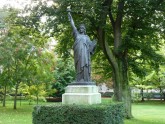
The grand opening of the sculpture took place on October 28, 1886. But she was not born easily and not quickly. The idea for this symbol came from the French scientist, lawyer and abolitionist Edouard René Lefebvre de Laboulaye back in the late 1860s. He proceeded from the fact that America and France were connected by old friendly ties. France provided moral and material support to the American struggle for independence—the French General Lafayette even became a national hero of the United States. Parisian liberals looked to the American Constitution as a model to follow. Laboulaye also belonged to this circle. Gathering a group of intellectuals, he proposed, as a sign of friendship with America, to give it a certain symbolic gift from the French people...

Soon the idea of a giant sculpture appeared. Laboulaye suggested that the author be the sculptor Frederic Auguste Bartholdi, who already had a reputation as a creator of monumental monuments. There is evidence that Bartholdi, when creating a statue for New York, which he called “Liberty Bringing Light to the World,” based his earlier design of a giant sculpture intended for Egypt. The sculptor actually visited there in the 1860s. Having met the builder of the Suez Canal, Ferdinand de Lesseps, Bartholdi suggested that the Egyptians create a huge sculpture with a lighthouse-lamp in hand for the opening of the water route between the Mediterranean and Red Seas.

The statue was to be called "Progress" or "Egypt Bringing Light to Asia." However, the ruler of Egypt, Ismail Pasha, did not accept this idea - apparently for financial reasons... The sculptor himself always denied the “Egyptian” origin of Liberty and insisted that the project intended for America was completely original. However, it is curious that it was Lesseps, who became a celebrity after the opening of the Suez Canal, who headed the committee to create the “Gift of France” to the United States...
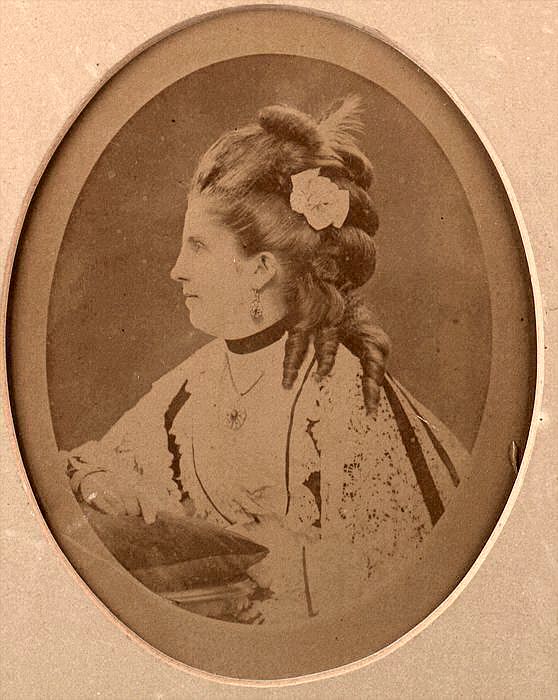
Isabella Boyer
There are many assumptions regarding who was the model of Freedom. Some, for example, believe that Bartholdi copied the sketch of the sculpture from his mother, Charlotte. According to one version, he even had an American model, Isaac Singer’s recently widowed wife Isabella Boyer. The mystery has not yet been solved...
Laboulaye advised Bartholdi to go to America, get to know this country, feel its spirit, and gain impressions. And the sculptor immediately found a place for the future monument - New York Harbor.
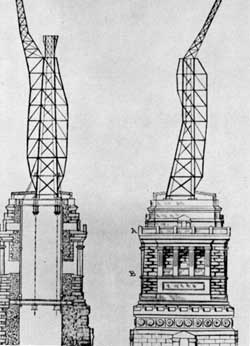
The complex internal frame of the statue was to be designed by Gustave Eiffel, who had already proven himself a specialist in creating original iron structures for railway bridges, and the future author of the famous Parisian tower. Fundraising for the creation of the giant sculpture began in 1874. It is noteworthy that for the opening of the “advertising campaign,” as it would now be called, a special cantata “Freedom” was written by composer Charles Gounod. Beginning in 1875, a team of twenty people worked in special workshops - seven days a week, ten hours a day... The body was made of copper sheets, which were manually given the required shape.
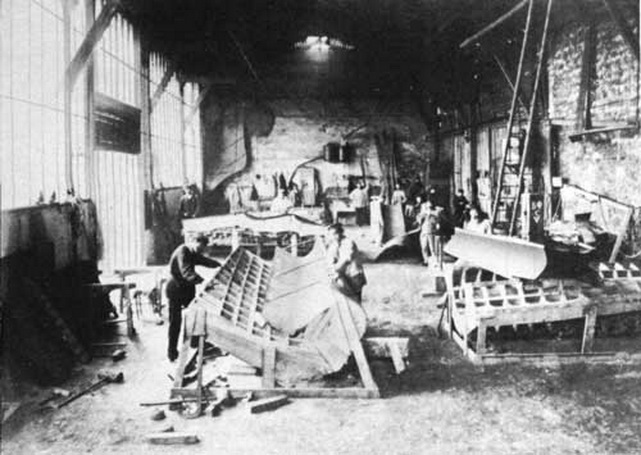
At first they planned to install the statue for the 100th anniversary of American independence, in 1876. But the work progressed extremely slowly. The creation of the statue was a joint French-American project, in which the American side erected the pedestal, and the French made the statue and then assembled it in the United States. However, there was a shortage of funds on both sides Atlantic Ocean. In France, donations, lotteries and entertainment events were held to raise funds.

The United States, in turn, held theatrical performances, art exhibitions and auctions to raise funds. Meanwhile, Bartholdi in France needed the help of an engineer to calculate the design of a giant copper statue. Alexander Gustav Eiffel, creator Eiffel Tower, developed a design for a powerful iron support and frame that allowed the copper shell of the statue to move freely while maintaining the balance of the statue itself.
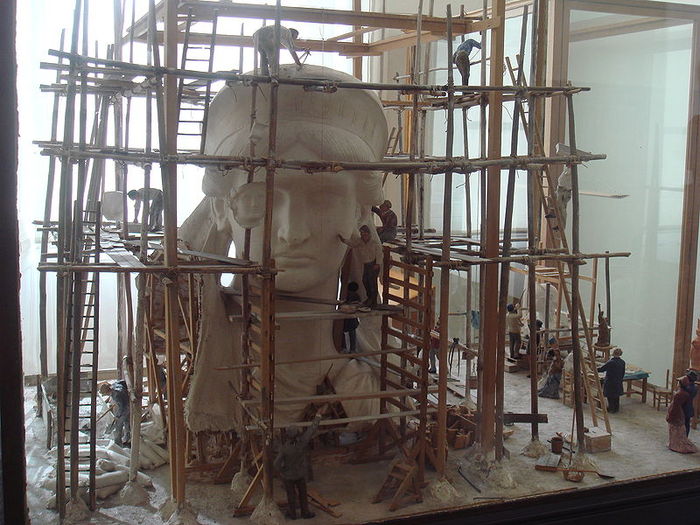
Funds for the pedestal were raised by August 1885, and its construction was completed by April 1886. The statue was completed in France in July 1884, and in June 1885 it was delivered to New York Harbor aboard the French frigate Isere. . The statue was transported from France to the United States in disassembled form - it was divided into 350 parts, packed in 214 boxes. Assembling the statue on the pedestal took four months. On October 28, 1886, the unveiling ceremony of the Statue of Liberty took place in front of a large crowd of people. She became a centenary gift that was 10 years late.
While France's fundraising problems were successfully solved by the lottery, in the United States there was little enthusiasm for the pedestal... Fundraising in America was faltering, so Joseph Pulitzer (famous for his name award) contributed pages to his World newspaper for articles in support of the fundraiser. In his newspaper, Pulitzer criticized both the rich, who did not want to finance the construction of the pedestal, and the middle class, who is accustomed to relying on the fact that wealthy compatriots will always have money for a good cause. Pulitzer's harsh criticism was successful and motivated Americans to donate. As a result of skillfully constructed propaganda, addressed to ordinary Americans and criticizing greedy moneybags, it was possible to collect donations in the amount of 100 thousand dollars (and at the same time significantly increase the circulation of the newspaper!).
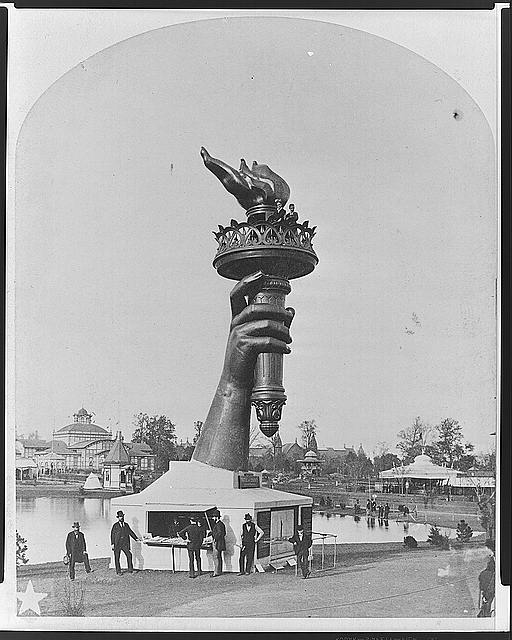
On international exhibition in Philadelphia, dedicated to the anniversary of American independence, they were able to deliver only a hand with a torch, and even then by the end of the exhibition. The delegation was then headed by Bartholdi. Having traveled to his chosen island, Bedlows Island in New York, the sculptor proposed that this piece of land be renamed Liberty Island. And so it happened 80 years later: in 1956, the island received the name Liberty Island.
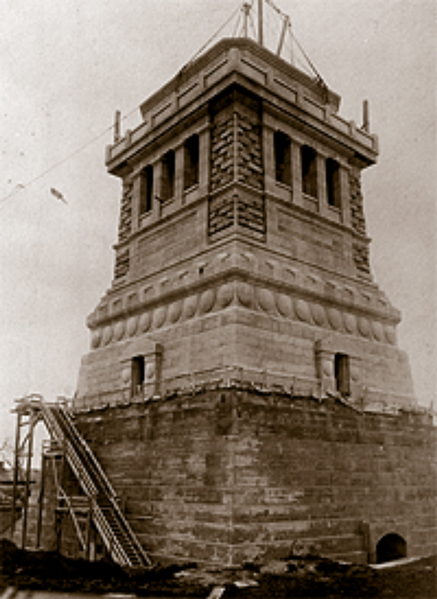
Now it was possible to begin the construction of the pedestal, the design of which was created by the American architect Richard Morris Hunt. The first foundation stone was laid on August 5, 1884. And in Paris, sculpture has long “outgrown” the workshop and risen above the city. In June 1884, construction of the statue was completed; On the Fourth of July, at a ceremony, it was “presented as a gift” to the representatives of America.
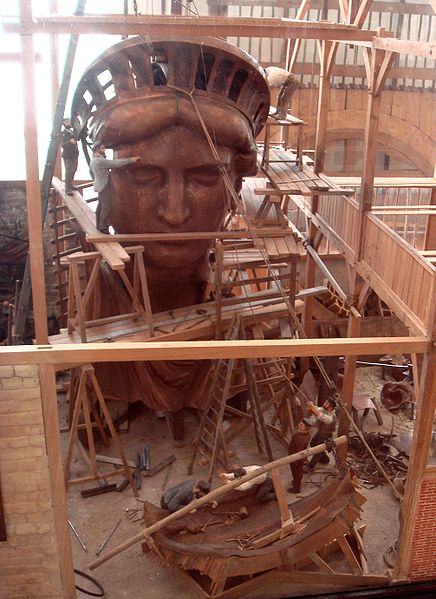
The following year, the statue, which weighed 225 tons, was dismantled into pieces and transported to the United States on the French frigate Isère. There the sculpture was reassembled - on a pedestal in New York. Bartholdi, arriving in America for the ceremony, said simply: “The dream of my life has come true.” At the unveiling of the statue on October 28, 1886, US President Cleveland declared: “We will not forget that freedom made its home here.” At this time, Bartholdi was in the head of the colossus - he had to cut the rope so that the blanket of the colors of the French flag would fall from the monument...
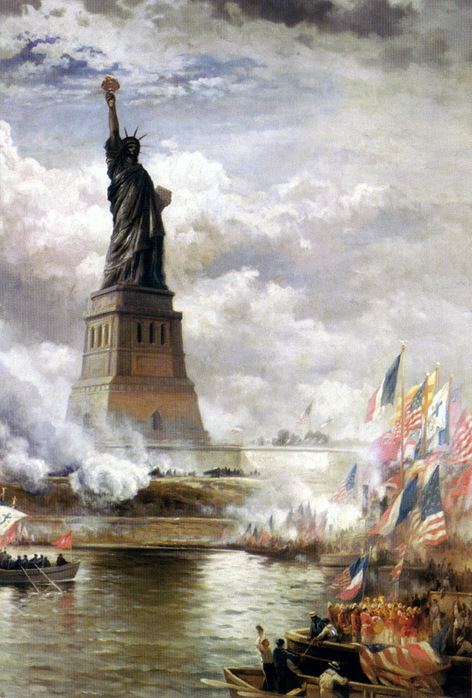
Since then, the famous statue has stood on Liberty Island, formerly Bedloes Island, on the site of the Fort Wood fortress, which once protected New York Harbor. The date Liberty holds in her left hand is July 4, 1776, the day American independence was declared.

And in 1903, another, smaller plaque with Emma Lazarus' poem "The New Colossus", written in 1883, was attached to the pedestal as part of a fundraising program for the construction of the pedestal. It is noteworthy that the poetess was not even able to attend the opening ceremony. Jeanne-Emilia, Bartholdi's wife, and Lesseps' eight-year-old daughter Totot were the only women allowed to attend the unveiling ceremony of the statue. This is, indeed, a historical curiosity: the ideas of freedom and equality did not yet apply to persons of the “weaker sex”!..
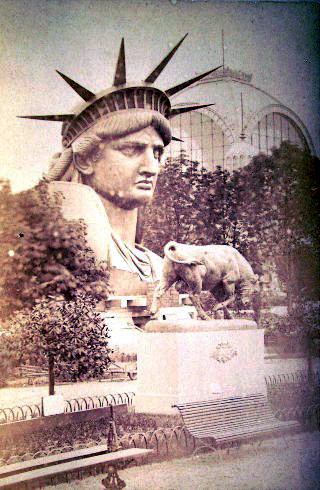
Head of the Statue of Liberty at the Paris World's Fair in 1878
On October 15, 1924, the statue was declared a national monument, and another 60 years later it was included in the List World Heritage UNESCO.
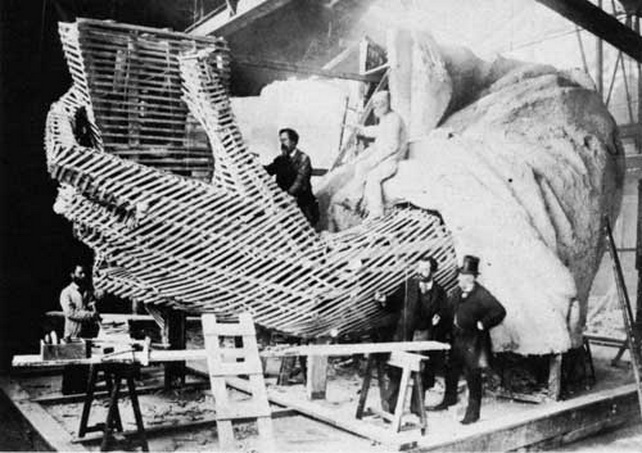
Over the more than century-long history of the statue, it was repaired and improved several times. The last major work was completed in 1986. Then the statue was illuminated with a laser for the first time. The image of the Statue of Liberty can be seen on New York State license plates. But she became a symbol of all of America. Even during the First World War, her images, as a “female version” of Uncle Sam, began to appear on posters calling for military valor.
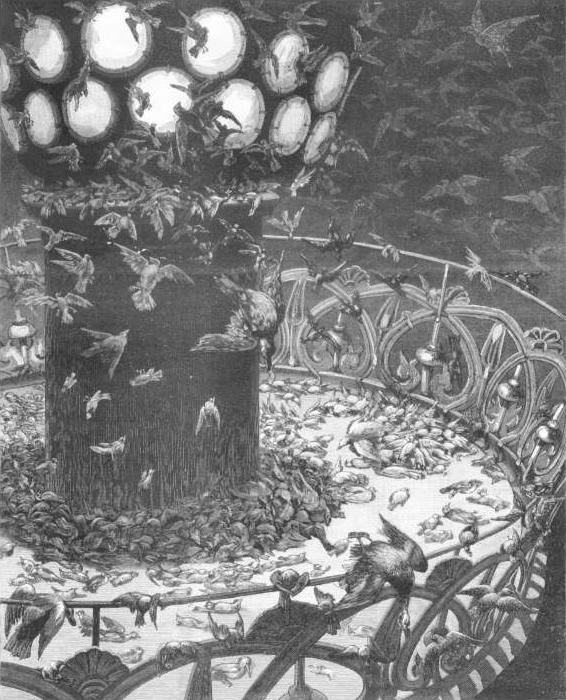
Since its discovery, the statue has served as a navigational landmark and was used as a lighthouse. Three keepers took turns keeping her torch lit for 16 years, but this had a detrimental effect on the birds.
Until 1899, the Statue of Liberty was the tallest structure in New York. Gradually, it was much “outgrown” by the skyscrapers of Manhattan. However, up close it still makes a majestic impression. And the flow of visitors to it does not stop - ferries depart one after another to the island.
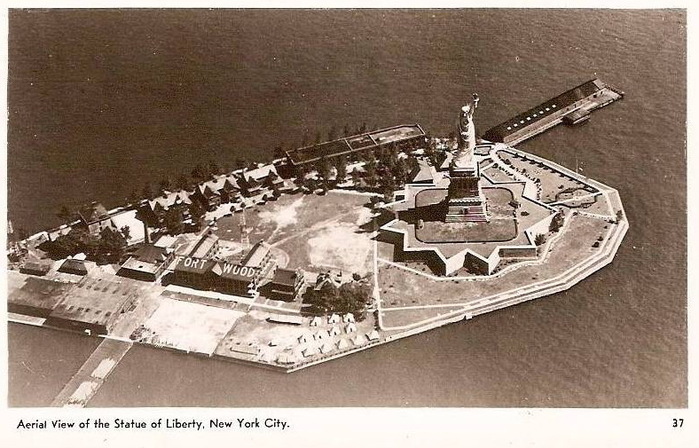
The story of the Statue of Liberty and the island on which it stands is a story of change. The statue was placed on a granite pedestal inside Fort Wood, built for the War of 1812, whose walls were laid out in the shape of a star. The US Lighthouse Service was responsible for maintaining the statue until 1901. After 1901, this mission was entrusted to the War Department. By presidential proclamation of October 15, 1924, Fort Wood (and the statue on its grounds) was declared a national monument, the boundaries of which coincided with the boundaries of the fort. In 1933, maintenance of the national monument was transferred to the National Park Service. On September 7, 1937, the national monument was enlarged to cover all of Bedlow Island, which was renamed Liberty Island in 1956. On May 11, 1965, Ellis Island was also transferred to the National Park Service and became part of the Statue of Liberty National Memorial. In May 1982, President Ronald Reagan appointed Lee Iacocca to lead a private sector effort to restore the Statue of Liberty. The restoration raised $87 million through a partnership between the National Park Service and the Statue of Liberty-Ellis Island Corporation, which became the most successful public-private collaboration in American history. In 1984, at the beginning of work on its restoration, the Statue of Liberty was listed by the UN as a monument of world significance. On July 5, 1986, the restored Statue of Liberty was reopened to the public during Liberty Weekend celebrating her centennial.
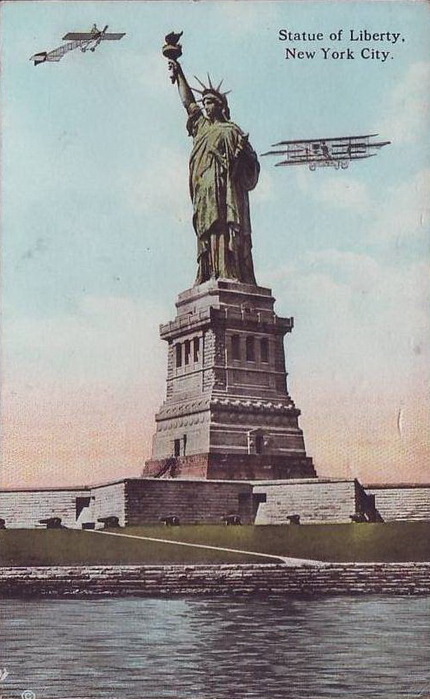
Visitors walk 354 steps to the statue's crown or 192 steps to the top of the pedestal. There are 25 windows in the crown, which symbolize the earthly gems and heavenly rays illuminating the world. The seven rays on the crown of the statue symbolize the world's seven oceans and continents. The plaque the statue holds in her left hand reads (in Roman numerals): “July 4, 1776.” The total weight of copper used to cast the statue is 62 thousand pounds (31 tons), and the total weight of its steel structure is 250 thousand pounds (125 tons). The total weight of the cement base is 54 million pounds (27 thousand tons). The thickness of the copper covering of the statue is 3/32 inches or 2.37 mm.

Most copies of the Statue of Liberty are located in its homeland - France. There are two of them in the center of Paris alone. One, measuring 46.50 meters, stands on Swan Island (Ile aux Cygnes). This was already a reciprocal gift from the United States to France. In addition to it, in the Luxembourg Gardens, there is the actual prototype of the Statue of Liberty, of a smaller size. This version was the model used by Bartholdi for the large version of the statue given to the Americans. On the banks of the Seine, on the Pont Alma, there is also a copy of the torch from the Statue of Liberty, donated by the United States to France in 1986. Tourists sometimes mistakenly consider it a monument to Princess Diana, who died in a tunnel under the bridge in 1997.

July 4, 2004 in honor of the 100th anniversary of the death of Frederic Auguste Bartholdi in his hometown Colmar in eastern France (Alsace province) a smaller 12-meter copy of the famous Statue of Liberty was installed. It was created on the basis of a 128-centimeter model stored in the Colmar Museum.
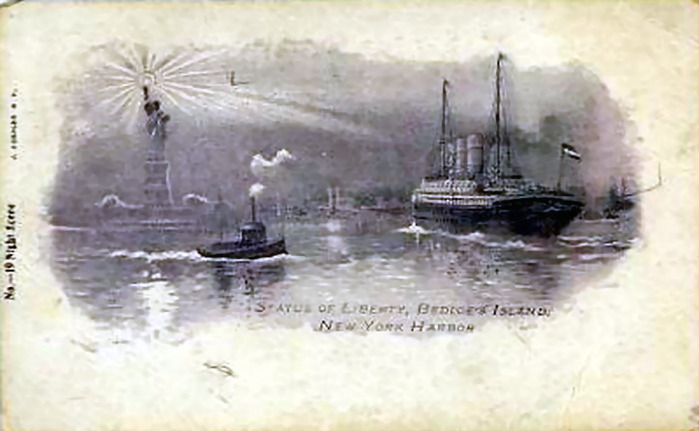
Today, there are more than 200 copies of the Statue of Liberty - in 39 US states, in several current and former US possessions, including the Panama Canal Zone, Guam, and the Philippines... In the Copenhagen quarter of Christiania - the “hippie city” where anarchy reigns, there is also its own Statue of Liberty, or rather, a parody of it, wittily made from auxiliary materials, reminiscent of both the original and a huge scarecrow. Well, everyone has their own understanding of this very freedom... france
The Paris Statue of Liberty is a symbol of the independence of two nations at the same time: French and American. The history of the Parisian statue is inextricably linked with the creation of the American monument. The author of the masterpiece in the USA is the French sculptor Frederic Auguste Bartholdi (1885). The role of the model was played by Isabella Boyler, the widow of Isaac Singer, a famous manufacturer of sewing machines. The American Statue of Liberty was intended as a gift from the French people to mark the centenary of the signing of the US Declaration of Independence.
It is noteworthy that Gustave Eiffel himself, the future creator of the Eiffel Tower, helped with the design of the American Statue of Liberty. Eiffel's challenge was to develop a massive steel support and intermediate frame that would allow the copper shell to move freely while remaining vertical. Copper was brought from Russia (from what is now Bashkortostan). German cement was used in the construction of the foundation.
Just 4 years later, America presented France with a return gift - an absolutely exact copy of the monument, but much smaller in height. “Liberty” in Paris has a height of only 11.5 meters, while “Freedom” in America is more than 4 times higher (the height is 46 meters, and if you take into account the pedestal and base, then 93 meters).
The main Parisian symbol of Freedom stands today on Swan Island (see the mark on the map, exact coordinates) not far from the Eiffel Tower. It is noteworthy that the woman’s face faces west, where the “American Big Sister” is installed. In the right hand of the “Parisian Liberty” there is a torch, and in the left there is a tablet with two dates: the revolutions in France and in America.
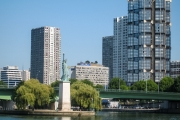
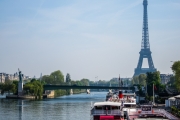
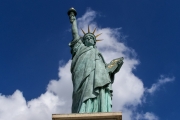
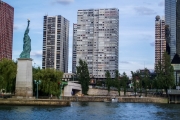
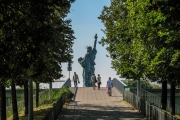
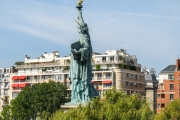
However, when you arrive in Paris, you will be pleasantly surprised by surprises: in the city of all lovers there is not one statue representing the freedom of the nation, but four! Just a haven for photo sessions. And if you are planning a honeymoon trip to Paris, we recommend photographer Arthur Yakutsevich (see link).

The second is located in the Museum of Arts and Crafts. This is the oldest European museum dedicated to technical topics. The third has a height of 2 meters and is located in the very center of the French capital, in the Luxembourg Gardens. To see the fourth, you need to climb the Eiffel Tower - the sculpture stands on a barge, which is moored to a pier on the right bank of the Seine River.
On the Alma Bridge there is a replica of the American "Liberty" torch, which America gave to the French people almost 30 years ago. In 1997, Princess Diana died under the Alma Bridge. Therefore, her fans made a monument out of the torch: both in winter and in summer, here you can see the flowers that people laid in her memory.
Statues of Liberty in other cities of France
Another copy of the famous monument is located in the city of Colmar (Alsace province, eastern France). The height of the copy is 12 meters. When creating it, a model with a height of 128 centimeters was used, which is stored in one of the city’s museums. It was installed 9 years ago - on July 4, 2004, in memory of the 100th anniversary of the death of the original creator, Frederic Auguste Bartholdi.
In Saint-Cyr-sur-Mer there is a gilded Statue of Liberty, its height is 6 meters. Its special feature is the torch, which is actually a lantern. It's lit in dark time days.
The Statue of Liberty in Paris is the “little sister” of the American Statue of Liberty. The building is a gift to the French from the Americans. The gift from the Americans is reciprocal; in 1885, it was the French who gave the Americans the original Statue of Liberty, which is installed in New York, on the 100th anniversary of the signing of the Declaration of Independence of the United States of America.
The statue is installed on Swan Island in the eastern part of Paris. The height of the statue is 11.5 meters, weight is 14 tons. Initially, the statue was facing east - towards the Eiffel Tower, but in 1937 it was turned around, and today it faces its “big sister” in New York Harbor - to the west.
Story
The Statue of Liberty in France is located in its very heart and attracts crowds of tourists. From the car window, driving along the embankment, you can see it in all its glory. The following people worked on the production of the original statue:
- sculptor Frederic Auguste Bartholdi;
- engineer Gustave Eiffel;
- his assistant Maurice Koechlin.
The model was Isabella Boyer. The prototype of the statue was the ancient Roman goddess Libertas.
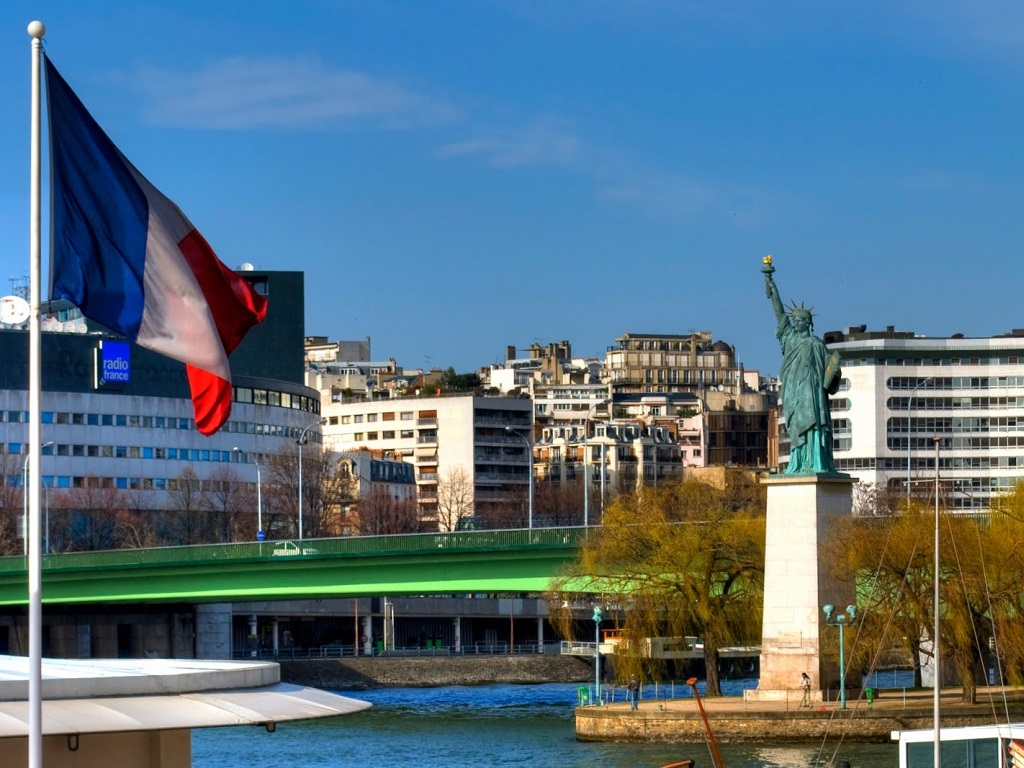
Based on the original, a copy was created, which was obviously inaccurate. It is also made of copper, its base is made of concrete, but has more modest dimensions (the scale of the copy in relation to the original is 4:1). In the left hand of the statue there is a tablet, and on it are two dates - one important for the French people - Bastille Day (July 14, 1789) and the second - important for the American people - the day of the US Declaration of Independence (July 4, 1776). There is only one date on the plaque of the American statue - July 4, 1776.
Even before the official opening of the New York Statue of Liberty, the American diaspora in Paris initiated fundraising for a return gift. Already in 1889 (four years after receiving the gift), the Americans presented a copy to the French.
How to get there
Swan Island is a narrow artificial dam on the Seine River near the Eiffel Tower. It was created in 1825 to support the pillars of Parisian bridges. To get to Paris's Statue of Liberty on Swan Island, you need to cross the Grenelle Bridge, which is close to Bir Akeim and Javel metro stations. The statue is surrounded by trees and there is a small area where you can take photo sessions. The park around the statue was completely renovated in 2012.
It is impossible to get to the attraction from the river, since the length of the island of 850 meters is not enough to equip the piers. But from any excursion boat that sails past Swan Island, the statue is clearly visible.
Other Statues of Liberty in France
In addition to the Statue of Liberty on Swan Island in France, there are three more of its analogues.
One is in the Museum of Arts and Crafts. Here the statue can be seen in all details. This statue is the first and main model that was completed by Bartholdi in 1878 and subsequently used to create the American Statue of Liberty.
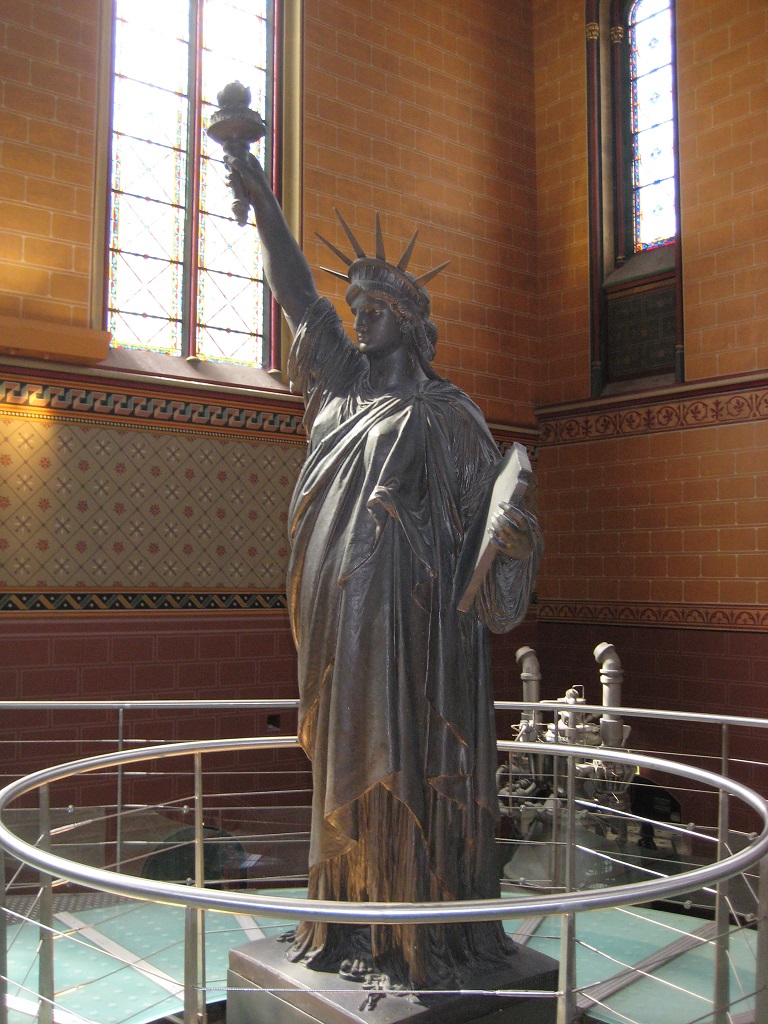
The second was created by Bartholdi to carry out World's Fair 1900, after which it was transferred to the Museum in the Luxembourg Gardens. In 1905, it was installed in the Luxembourg Gardens, where it stood for more than a century - until 2012. Today it adorns the entrance to the Orsay Museum, and in its place in the Luxembourg Gardens stands a new bronze copy.
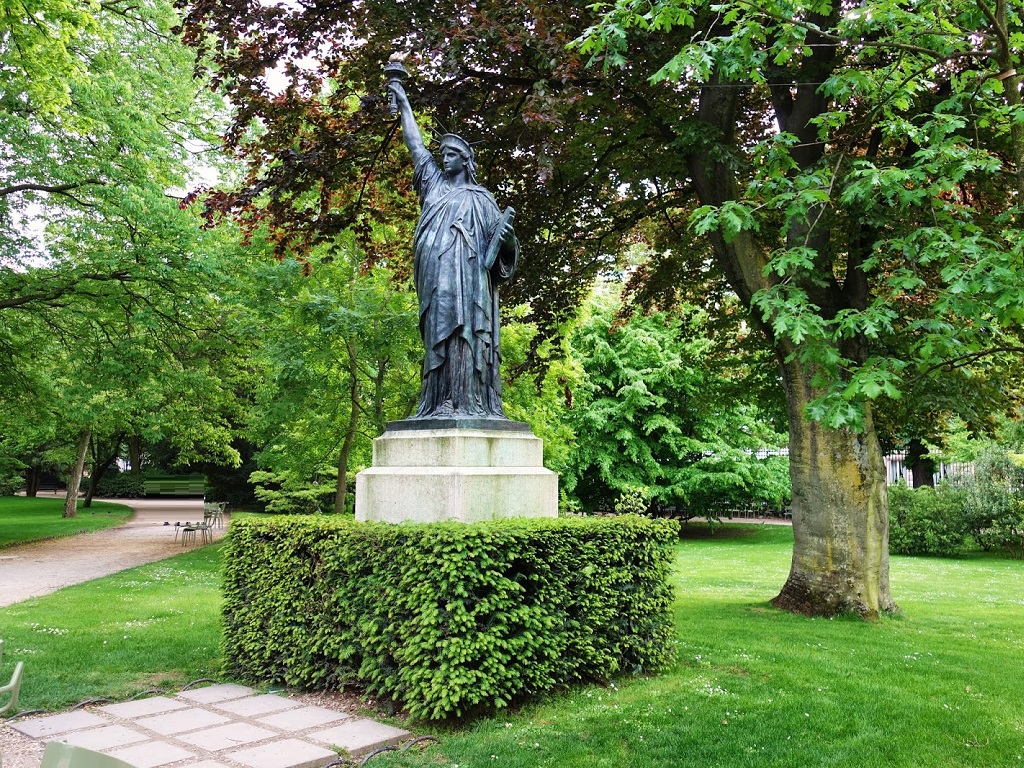
The third is located on the bow of the barge "Nina", moored near the Eiffel Tower.
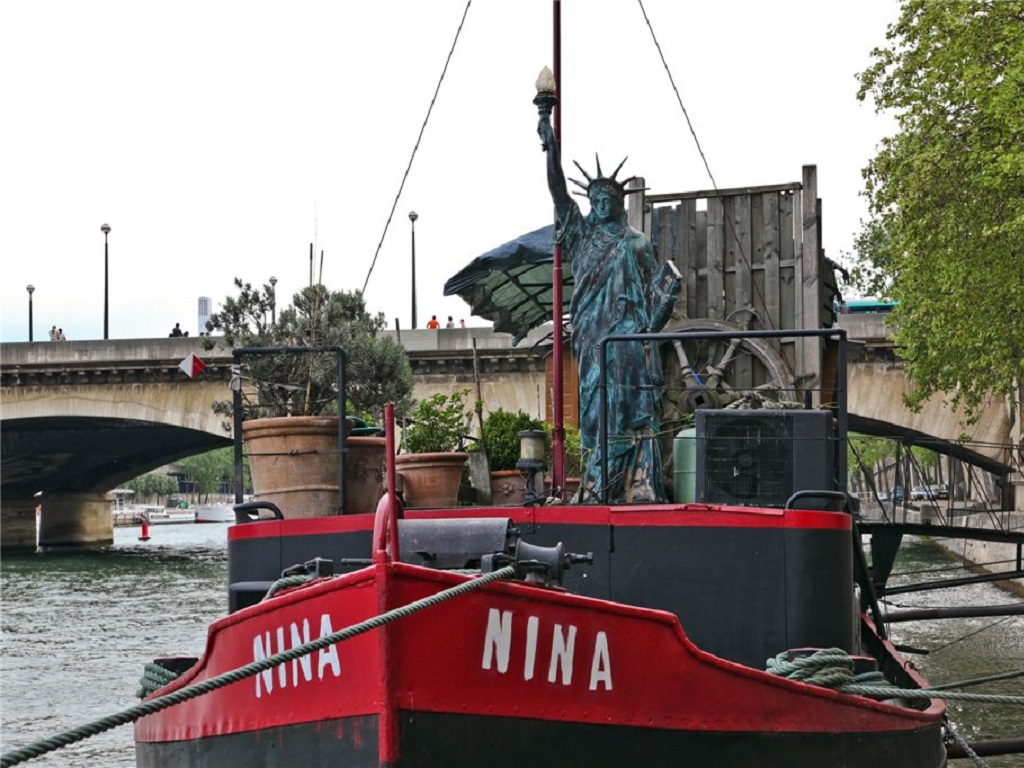
The Alma Bridge is decorated with the Flame of Liberty - a gilded, full-size replica of a sculpture element of the American Statue of Liberty. The Americans also presented it to the French. In 1997, Princess Diana died under the Alma Bridge, and her fans turned the Flame of Freedom into a monument to the princess - you can always see fresh flowers near it.
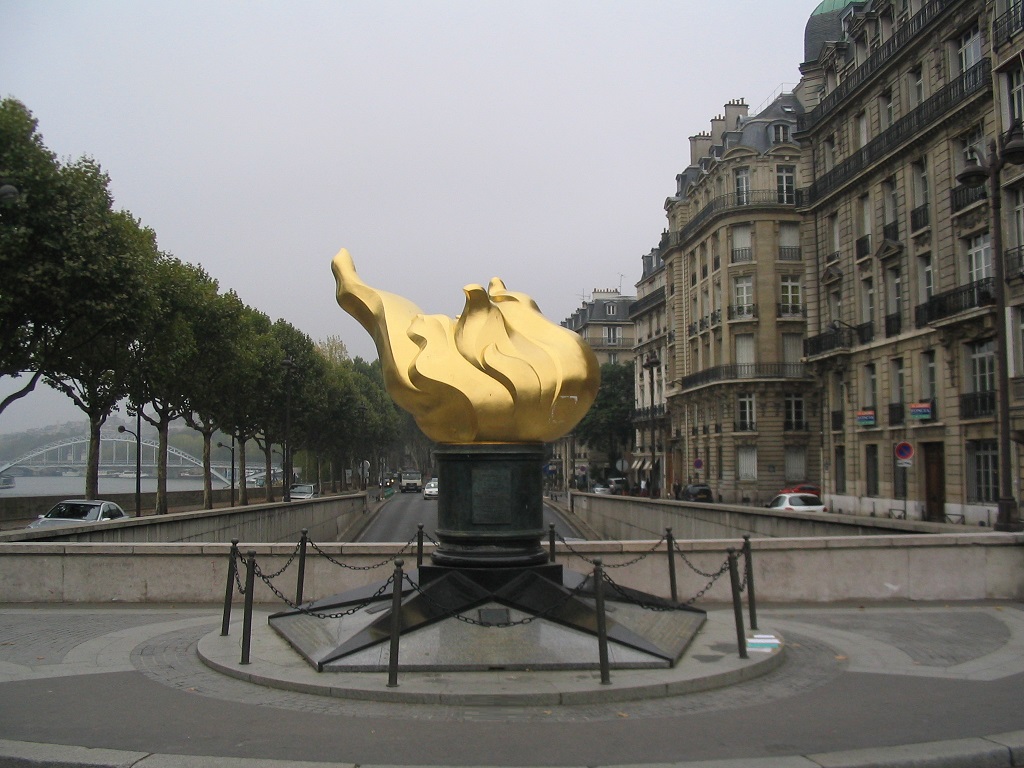
- The copper for the statue was brought from Russia. It was obtained from the Republic of Bashkortostan, and according to other sources, it was smelted at a copper smelter in Nizhny Tagil. German cement was used in the construction of the pedestal.
- The Paris Statue of Liberty was officially unveiled on US Independence Day, July 4, 1889, by French President Sadi Carnot.
- The Paris Statue of Liberty on Swan Island can be seen in the film National Treasure: Book of Secrets, released in 2007.
Historically, the main attraction of the United States of America takes its roots from France. In Paris you can find three such monuments of different sizes. The most famous is located on Swan Island, near the Eiffel Tower.
Paris Statue of Liberty on Swan Island
The eastern part of Swan Island became home to a smaller Statue of Liberty. Rising on a concrete pedestal, the copper lady, 11.5 meters high, peers into the distant shores of the American continent. Initially, the monument looked east, and only at the end of the 1930s did its gaze turn to the west.
The monument is entirely made of copper fragments, which are attached to a durable metal frame in a special way, where the seams are practically invisible. Copper ore for casting was specially imported from Russia, and the frame underwent many tests with strong winds and water before installation.
Despite the fact that the statues are almost identical, as was originally intended, they still differ in two ways. The first is the size; as you know, the Paris Statue of Liberty has been reduced by 4 times. But the second difference is not so noticeable, but still, if you look at the code of laws that the lady is holding in her left hand, you can see a different number of dates. The French one has two dates, while the American one has one.
Other copies of the Statue of Liberty
Another similar exhibit is on display at the Museum of Arts and Crafts. The size of the statue allows everyone to come up and examine Miss Liberty down to the smallest detail. It is she who is the first model, according to which the sculptor Auguste Bartholdi later created the famous “Freedom Illuminating the World”, known to many. 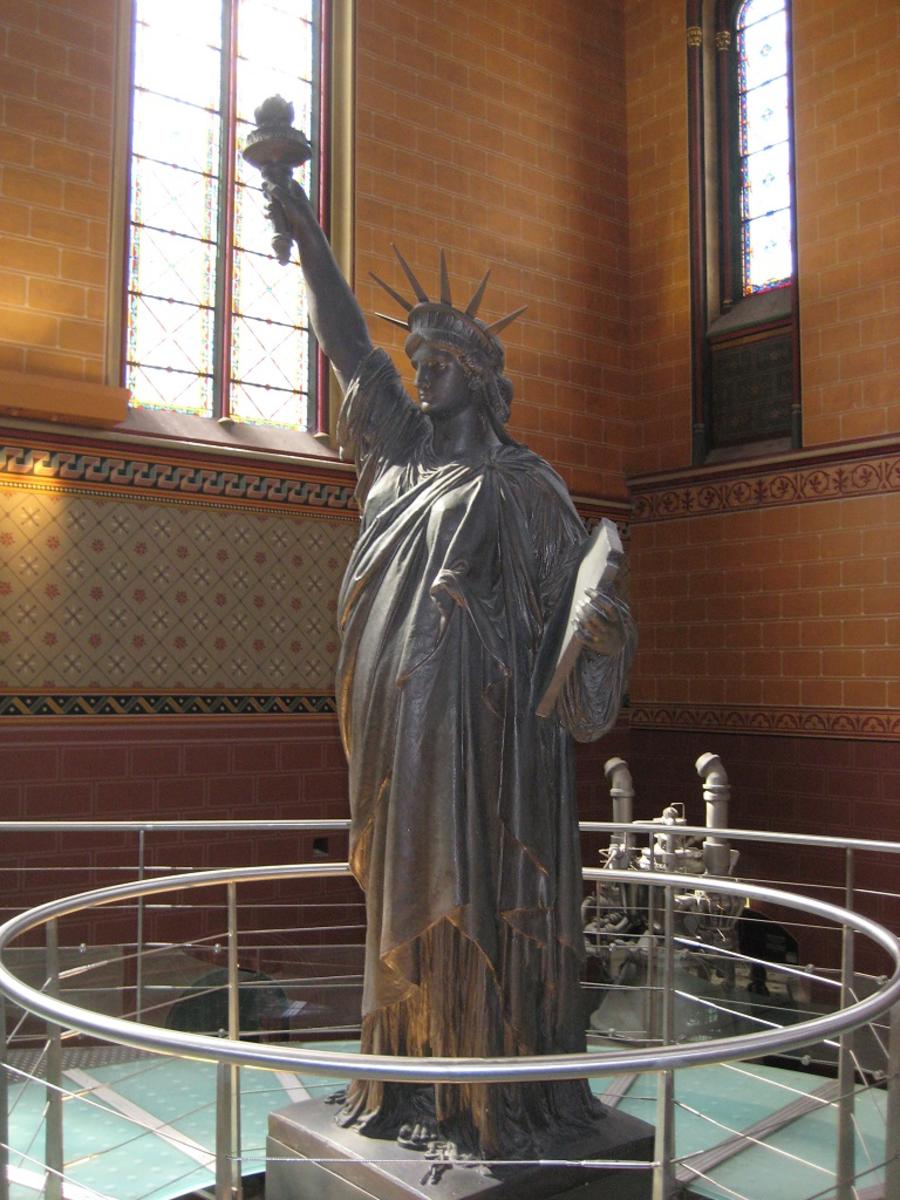
The second statue is located at the entrance to the Orsay Museum. It has been here since 2012, before that it was located on the territory of the Luxembourg Gardens.
The third bronze Statue of Liberty is located in the Luxembourg Gardens. It was installed immediately after the previous version was moved to the Orsay Museum. 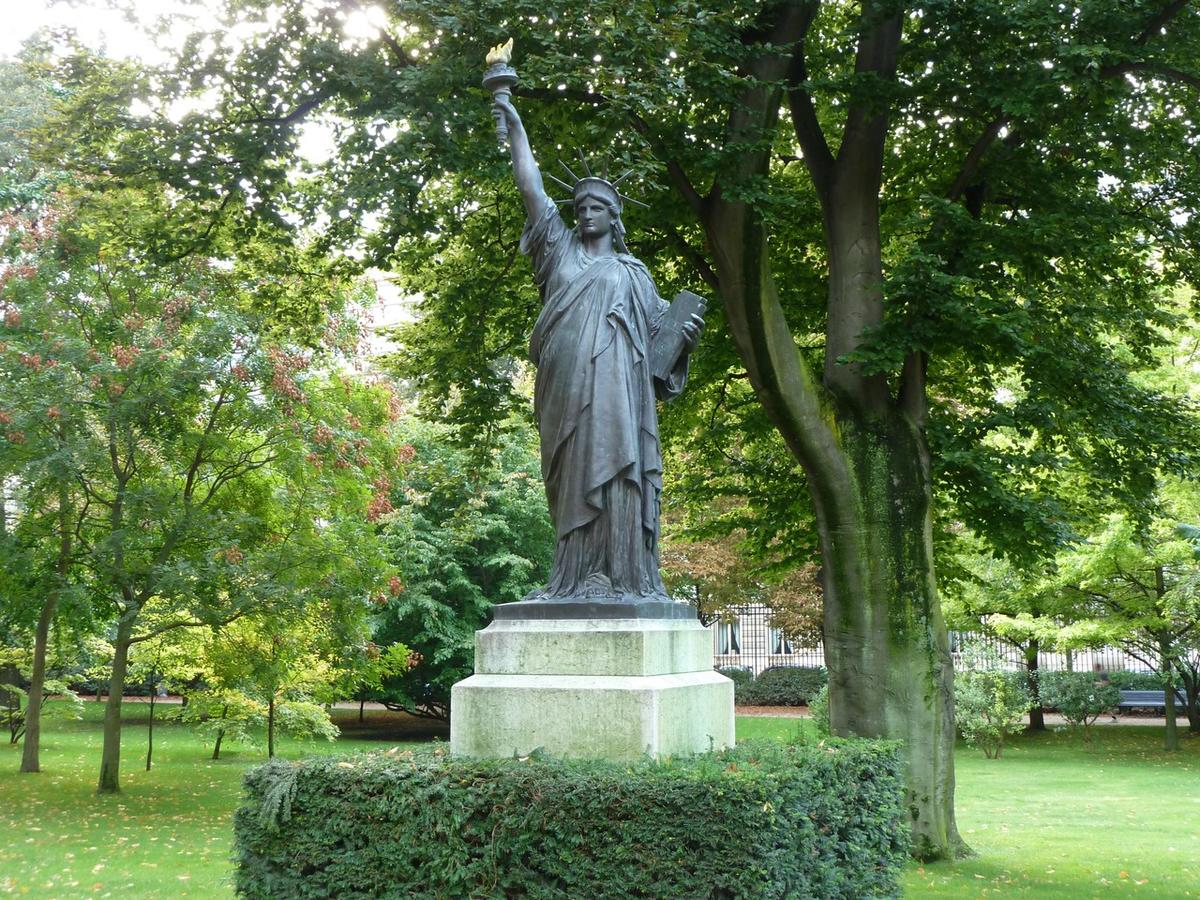
For all the time, the Statue of Liberty on Swan Island left its place only once. This happened in 1998, when Japan officially declared the Year of French Culture. Among the many exhibits from various museums, the country Rising Sun The Paris Statue of Liberty also went. Her temporary place of residence was the island of Odaiba in Tokyo Bay. It is worth noting that for many Japanese residents this was a discovery. Few of them knew about the origin of America's "Liberty Enlightening the World"
Gifted as a sign of mutual cooperation between the two peoples, the monument quickly lost its original purpose. Over time, this statue of the sculptor Bartholdi turned into a symbol of human freedom and independence, not of an individual people, but of all humanity.
Updated: 12/22/2016If you decide to visit the capital of France, then it will not be enough for you to see the Eiffel Tower and flea markets. One of the striking attractions of these places is the Statue of Liberty in Paris, which is a copy of the American famous monument. But at the same time, the dimensions of the French analogue are, of course, more modest.
According to historical data, the Statue of Liberty in the city of Paris was erected in honor of the centenary of the signing of the US Declaration of Independence. It should be noted that Russia took part in the creation of the monument. The copper from which the lady with the torch in her hand is made is a domestic product.
Paris Statue of Liberty and interesting facts about it
 When asked where the Statue of Liberty is located in Paris, we can safely say that it is located in the very center French capital. Her address is eastern part of Swan Island, which is located on the Seine River next to the Grennel Bridge. This attraction is surrounded by trees and there is a small area around it. So you can conveniently conduct photo sessions here. At the same time, getting to the Statue of Liberty in Paris is quite easy. And many tourists take advantage of this.
When asked where the Statue of Liberty is located in Paris, we can safely say that it is located in the very center French capital. Her address is eastern part of Swan Island, which is located on the Seine River next to the Grennel Bridge. This attraction is surrounded by trees and there is a small area around it. So you can conveniently conduct photo sessions here. At the same time, getting to the Statue of Liberty in Paris is quite easy. And many tourists take advantage of this.
The author of this monument is the sculptor Frederic Auguste Bartholdi. And Isabella Boyer acted as a model. It is its features that are fully conveyed by the French copy of the Statue of Liberty. The height of this structure is only 11.5 meters. This is 4 times less than the original. But, despite such dimensions, this monument looks quite impressive.
There is more than one Statue of Liberty in Paris!
In fact, copies this famous monument on the territory of Paris 4 . All other Parisian Statues of Liberty are even more modest in size than the version described above. And their locations are scattered throughout the city.
- Thus, one of the symbols of independence is located at the Museum of Arts and Crafts.
- Another 2-meter statue flaunts in the Luxembourg Gardens.
- The last Parisian symbol of independence is located on the right bank of the Seine. Its location is a moored barge. According to numerous reviews, this monument is clearly visible from the Eiffel Tower.
Statue of Liberty on the map of Paris:
